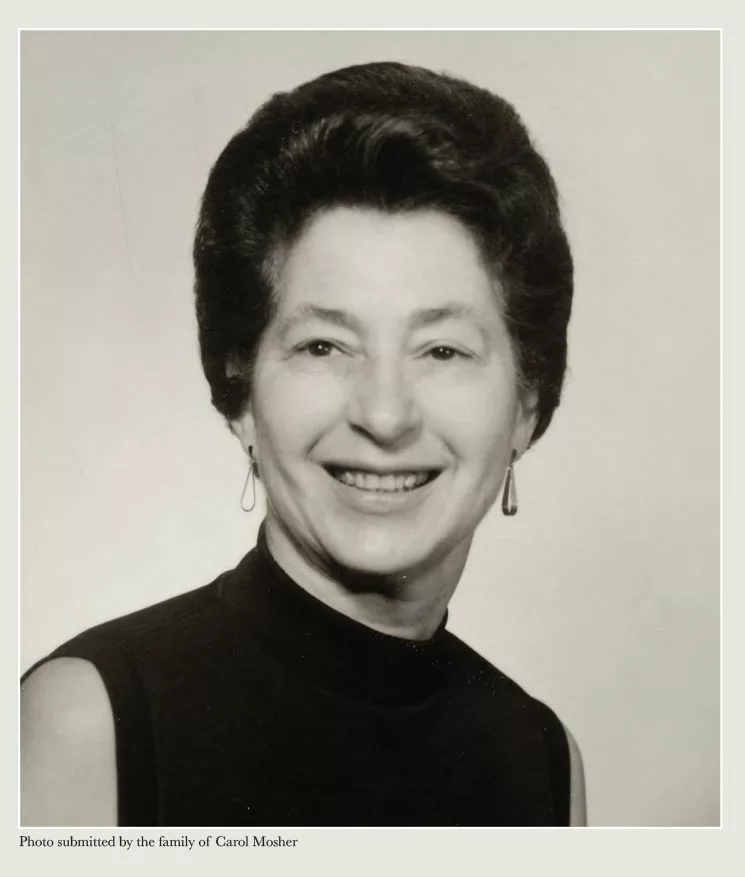
At their home in Palo Alto, Calif., on the Stanford University campus, the Mosher family had a small blackboard by the back door and used it to jot down grocery lists, reminders about doctors’ appointments, and prompts to feed the dog. But those daily minutiae often were replaced by structural formulas of chemical compounds – chalk-drawn diagrams reflecting big scientific questions and ideas.
Not surprising. The heads of this household were Harry and Carol Mosher, well-known chemists in the Stanford and Silicon Valley scientific communities, who together established the thriving Santa Clara Valley Section of the American Chemical Society, as well as an enduring annual award given by the group to a scientist successfully working to advance the field of chemistry.
Carol Mosher, who is 97 years old and resides in an assisted-living center, earned a bachelor’s degree in chemistry from Colorado State University in 1942. After her wartime graduate work, Mosher built a career researching the formation and activity of complex chemical compounds, including anti-cancer agents; she was a forerunner in the field of medicinal chemistry.
When asked by one of her daughters why she became a chemist, Mosher explained, “Back in those days, women either became secretaries or nurses, and I didn’t want to be either.”
Harry and Carol Mosher met as doctoral students at Pennsylvania State University and moved to Palo Alto in 1947, when Harry joined the Stanford chemistry faculty. The years after World War II were heady times for science and technology in the United States, as research funding blossomed and Cold War political hostilities drove competition and remarkable innovations. The Moshers were in the thick of it.
Groundbreaking research
Harry Mosher, who died in 2001, became the better-known of the two: He was a professor of organic chemistry; conducted and published research in natural-products chemistry and stereochemistry; and invented the “Mosher Reagent,” which has been widely used to measure the left- or right-handedness in organic molecules, according to a Stanford news release.
Yet Carol Mosher – who had three children, hosted faculty parties, and welcomed her husband’s graduate students to many Thanksgiving dinners – was, by definition, a groundbreaking scientist. Also an organic chemist, she was among the first research scientists hired by the fledgling Stanford Research Institute International. Her employee badge number was “007,” her son, Stephen Mosher, said.
In 1947, when Mosher started work at SRI International, she conducted bench science on the Silicon Valley campus in what her son recalled as Quonset hut-style buildings. Since then, SRI International has grown into a scientific leader, with 20 locations that in the past decade have completed more than $4 billion in sponsored research and development for government agencies and corporate clients, according to the company website.
From the scientific ground floor, Mosher rose to become a senior organic chemist in the bio-organic chemistry section of the institute’s life sciences division. Her investigations centered on the synthesis of a wide variety of organic compounds, including detergents and plasticizers, and a number of anti-cancer agents. She also studied the interactions of those compounds with DNA. Such research provides a basis for understanding compounds that might enhance or endanger human health and quality of life.
In 2000, Mosher was invited to present an overview of her career, including her study of anti-cancer agents, to a national meeting of the American Chemical Society. She authored or co-authored 28 scientific papers and patents, many published in the Journal of Medicinal Chemistry, and she served as an officer for the American Chemical Society’s Santa Clara Valley Section, which she helped to found.
Her son recently scanned one of those papers, published in 1978 in the journal of Nucleic Acids Research, titled “Synthesis, DNA-binding, and biological activity of a double intercalating analog of ethidium bromide.”
“You lost me at ‘synthesis,’” he said, with a laugh.
Honor alumna
Mosher grew up near Loveland, Colo., with two brothers who also attended CSU. She was a straight-A student – except for physical education – and, in the words of her brothers, “She’s the one who had the brains.” After receiving her bachelor’s degree from CSU, Mosher attended Penn State, earning a master’s degree in textile chemistry and a Ph.D. in organic chemistry, remarkable achievements for a woman in the ’40s. She received an Honor Alumna Award from CSU’s College of Natural Sciences in 1989.
Mosher’s three children, all in their 60s, remember their parents discussing chemistry and research challenges at the family dinner table beginning in the 1950s. It seemed like a normal part of living in an academic community, they said, and their mother never talked about the rarity of her role as a woman in scientific research.
Now, however, it’s clear her career was unusual. In recent years, respected journals and news media have published a steady stream of critiques about the comparatively few women working in scientific research, noting the ramifications seen in stymied careers and innovations.
Against that backdrop, Stephen Mosher and his sisters have gained new respect for their modest mother and her career.
“It was pretty remarkable that she was in the sciences at that time,” he said. “Now we realize it was unusual.”